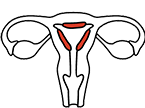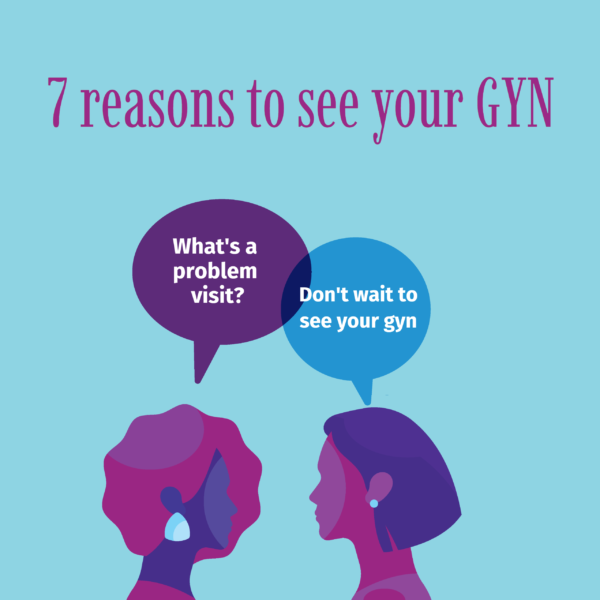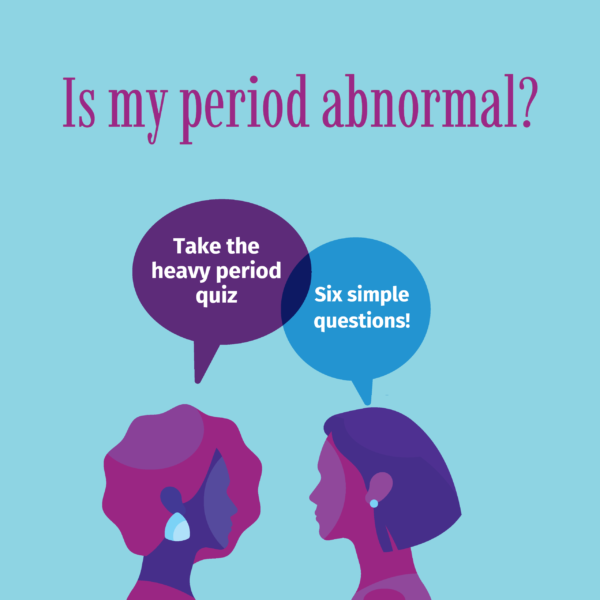Is a hysterectomy the only option for my heavy period bleeding?
If you experience heavy, long or inconsistent periods month after month (or even in between), you may have thought about having a hysterectomy to get rid of your uterus altogether! That is completely understandable when it feels like life revolves around your period. This article describes a common medical condition called Abnormal Uterine Bleeding and other, less invasive options to treat your period.
We asked OBGYN Kent Meldrum, MD to dispel a common misconception: that hysterectomy is the only option to treat heavy periods. Dr. Meldrum is a board-certified OBGYN practicing at May-Grant Obstetrics and Gynecology in Lancaster, PA. Their team of physicians, nurse practitioners, and midwives pride themselves on providing women with treatment options based on their individual needs. While there are situations where a hysterectomy is necessary, Dr. Meldrum believes that it may not be the best option for some patients with heavy bleeding.
Before diving into treatment options, let’s define a “heavy period”. At the start, we mentioned the term Abnormal Uterine Bleeding (AUB). AUB is a common medical condition defined as menstrual bleeding outside the normal volume, duration or frequency1. According to Dr. Meldrum, “the most important criteria to determine if a patient’s bleeding is abnormal is if it is affecting their quality of life.” He says, “If it’s affecting their ability to do what they need and want to do, that’s a problem. And that’s what we want to work together to fix.”
What are the symptoms of AUB?




- Periods lasting longer than 7 days
- Soaking pads & tampons quickly
- Passing large clots
- Cramps
- Bloating
- Pain during sex
- Fatigue
- Mood changes
What are the causes of AUB?
AUB comes with a variety of causes and symptoms and is much more complicated than just blood flow. The International Federation of Gynecology and Obstetrics (FIGO) classifies AUB according to the various causes which may include hormone imbalances, structural abnormalities, infections, medications or in some cases, cancer2,3.
There is much discussion online and in the news about fibroids, but let’s talk about one of the causes of AUB that you may not have heard about. AUB-E.

This diagnosis suggests there are irregularities in hormone levels during the shedding and repairing of the Endometrium, which can lead to endometrial tissue that is thicker than normal, resulting in a heavy and long period, often with large blood clots. AUB-E is an exclusion diagnosis which means that fibroids and polyps (and other common causes) have been ruled out as the cause of your heavy period.
It is important to notify your gynecologist if you are having any symptoms of AUB. They will perform a series of exams and tests to determine the cause and discuss treatment options with you. The good news is that there are treatment options specifically designed to treat AUB-E.
What are the treatment options for AUB-E?
Hysterectomy is not your only option4. Treatments range from medical management to major surgery. A woman may decide to choose hormone-based medical management, such as birth control pills or an IUD (Intra Uterine Device), to control their bleeding. This option may be a good option for some, but there are issues to consider such as breakthrough bleeding and regular follow-up with your doctor5.
If you are considering a hysterectomy, it is important to consider the potential long-term effects of the surgery, in addition to the fact that there are approximately 90 deaths each year due to complications related to this major surgery6.
Mayo Clinic researchers found the long-term effects of a hysterectomy may include an increased risk of high blood pressure, hypertension, coronary artery disease, obesity, depression and anxiety7. International studies have shown an association between hysterectomy and the risk of developing diabetes, not connected to an unhealthy diet or physical activity levels8.
When performed for benign causes, such as AUB-E, women who received a hysterectomy experienced an increased risk for pelvic organ prolapse and urinary incontinence 9. There is also research that showed an increased risk of thyroid, kidney and other cancers10. It is not a decision that should be taken lightly. Empower yourself with this information, ask the important questions and be sure to consider all options for treating your heavy period bleeding.
Endometrial ablation offers a safe and effective treatment option if you have been diagnosed with AUB-E. Dr. Meldrum says, “fortunately, endometrial ablation is an effective option for treating heavy periods.” Endometrial ablation is a minimally invasive treatment that permanently removes endometrial tissue that lines the inside of the uterus, the source of your heavy period. This treatment should be considered for premenopausal women who are done childbearing.
While there are a few endometrial ablation treatments on the market today, not all options are the same. For instance, Dr. Meldrum prefers the Minerva ES® Endometrial Ablation by Minerva Surgical because he can offer the treatment in the comfort of his office.
When we asked him to describe some of the benefits to an in-office treatment he said, “The patient doesn’t have to fast before the procedure, no anesthesia is required, and the process is simple.” He explains, “everything happens at your doctor’s office, with the healthcare provider, nurses, and staff you know as opposed to registering at the hospital, being in an operating room, and later moving to recovery. It’s just convenient for the patient.”
Endometrial ablation with Minerva ES is a safe, simple and effective 2-minute treatment that may improve or eliminate your heavy period. It is the most effective endometrial ablation treatment in the history of clinical trials conducted for FDA (Food and Drug Administration) approval, with 72% of women having their period totally eliminated at 12 months*11.
- One-time treatment
- No incisions
- No hormones
- No implants
- 1-2 day recovery
- Keep your uterus
- In-office treatment options
Ask your healthcare provider if a Minerva ES is right for you.
You can find contact information for Dr. Meldrum and May-Grant OBGYN, or a gynecologist near you, using the find a GYN tool on our website.
For more information on the Minerva ES Endometrial Ablation System, visit the Treatments page.
The Minerva ES® Endometrial Ablation System is intended to ablate the endometrial lining of the uterus in pre-menopausal women with menorrhagia (excessive bleeding) due to benign causes for whom childbearing is complete. The most common side effects of endometrial ablation occur during or immediately following the procedure and include uterine cramping, vaginal discharge, bleeding or spotting, nausea and/or vomiting, fatigue, and abdominal pain. As with all endometrial ablation procedures, serious injury or death can occur.
CAUTION: Federal law (USA) restricts this device to sale by or on the order of a physician. Rx only. The physician using the system must have sufficient and adequate experience in performing procedures in the uterine cavity.
For Indications and a complete list of contraindications, potential adverse events, warnings and precautions, visit www.minervasurgical.com/safety.
Results and patient experience may vary. Talk to your doctor about the right treatment for you.
*Results from different clinical investigations are not directly comparable. Information provided for educational purposes only.
References:
1.Committee on Practice Bulletins—Gynecology. Practice bulletin no. 128: Diagnosis of abnormal uterine bleeding in reproductive-aged women. Obstet Gynecol. 2012 Jul;120(1):197-206. DOI: 10.1097/AOG.0b013e318262e320. PMID: 22914421.
2.Munro MG, Critchley HO, Broder MS, Fraser IS. FIGO Working Group on Menstrual Disorders. FIGO classification system (PALM-COEIN) for causes of abnormal uterine bleeding in nongravid women of reproductive age. Int J Gynecol Obstet. 2011 Apr;113(1):3-13. DOI: 10.1016/j.ijgo.2010.11.011.. PMID: 21345435.
3.Cleveland Clinic. Abnormal Uterine Bleeding. Available at: https://my.clevelandclinic.org/health/diseases/15428-uterine-bleeding-abnormal-uterine-bleeding. Published November, 11, 2021. Accessed December 19, 2022.
4.Committee on Practice Bulletins—Gynecology. Practice bulletin no. 557: Management of acute abnormal uterine bleeding in nonpregnant reproductive-aged women. Obstet Gynecol. 2013 Apr;121(4):891-896. DOI: 10.1097/01.AOG.0000428646.67925.9a. PMID: 23635706.
5.The Food and Drug Administration. Labeling for combined hormonal contraceptives guidance for industry. Available at: https://www.fda.gov/regulatory-information/search-fda-guidance-documents/labeling-combined-hormonal-contraceptives-guidance-industry. Published January 2018. Accessed July 14, 2022.
6.Keshavarz H, Hillis SD, Kieke BA, Marehbanks PA. Hysterectomy Surveillance — United States, 1994-1999. MMWR Surveill Summ. 2022 Jul;51(SS05);1-8
7.Laughlin-Tommaso SK, Khan Z, Weaver AL, Smith CY, Rocca WA, Stewart EA. Cardiovascular and metabolic morbidity after hysterectomy with ovarian conservation: a cohort study. Menopause. 2018 May;25(5):483-492. DOI: 10.1097/GME.0000000000001043. PMID: 29286988
8.Chiang CH, Chen W, Tsai IJ, Hsu CY, Wang JH, Lin SZ, Ding DC. Diabetes mellitus risk after hysterectomy: A population-based retrospective cohort study. Medicine. 2021 Jan ;100(4):e24468. DOI: 10.1097/MD.0000000000024468. PMID: 33530258.
9.Forsgren C, Lundholm C, Johansson AL, Cnattingius S, Zetterström J, Altman D. Vaginal hysterectomy and risk of pelvic organ prolapse and stress urinary incontinence surgery. Int Urogynecol J. 2012 Jan;23(1):43-8. DOI: 10.1007/s00192-011-1523-z.. PMID: 21850508.
10.Wilson LF, Tuesley KM, Webb PM, Dixon-Suen SC, Stewart LM, Jordan SJ. Hysterectomy and Risk of Breast, Colorectal, Thyroid, and Kidney Cancer – an Australian Data Linkage Study. Cancer Epidemiol Biomarkers Prev. 2021 May;30(5):904-911. DOI: 10.1158/1055-9965.EPI-20-1670. PMID: 33619026.
11.Laberge P, Garza-Leal J, Fortin C, Grainger D, Johns DA, Adkins RT, Presthus J, Basinski C, Swarup M, Gimpelson R, Leyland N, Thiel J, Harris M, Burnett PE, Ray GF. A Randomized Controlled Multicenter US Food and Drug Administration Trial of the Safety and Efficacy of the Minerva Endometrial Ablation System: One-Year Follow-Up Results. J Minim Invasive Gynecol. 2017 Jan 1;24(1):124-132. DOI: 10.1016/j.jmig.2016.09.009.. PMID: 27687851.
K0237 Rev. A




